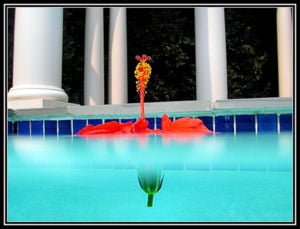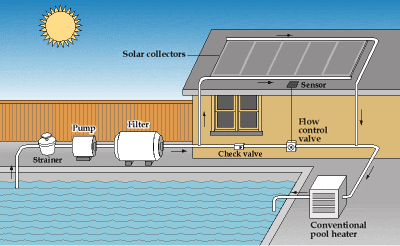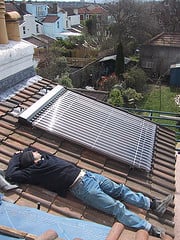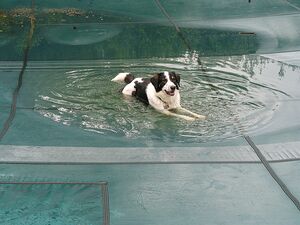
Energy derived from the sun drives and sustains life on earth. So why can't it heat your pool?
Swimming pools... your skin tingles in anticipation of diving in clear cool water on those ridiculously-roastingly hot summer days. This precise moment of contact makes all the hassle of cleaning and caring for your pool worth it, does it not? Now if only the scorching days lingered longer so you could laze a bit more in your backyard tropical-wannabe paradise. Alas, the seasons don't listen to you, and inevitably fall, winter and spring attack your precious pool, chilling it to its tiled bones, making it completely unusable to you. Much of the year your pool sits, unused and unloved, like a dog eagerly awaiting the return of its owner, like a dormant daffodil bulb waiting for the snow melt, like a ... Just as surely as we weren't sent here to Earth to suffer, surely we can all get what we want. And if for you that includes a heated pool without the financial and environmental expenses of fossil fuels, then welcome to the wide world of solar hot water systems.
The Way it Works[edit | edit source]
You may be familiar with solar domestic hot water systems- they typically take a relatively small amount of water and raise the temperature to about 140° F. Solar pool heaters differ in that they have to heat up thousands of gallons of water to only about 80° F.[1] The most cost-effective use of solar energy today is to heat swimming pools- they require low temperature heat, which is where solar collectors are most efficient. Each time the water passes through the solar collectors it is heated 2-5° F. A properly sized solar system can raise the pool temperature 10-20° F and maintain a comfortable swimming temperature.[2]
These systems make life more enjoyable for its owners by taking the water, circulating it through the collectors to heat it up, then sending it back for warm pool deliciousness.[3] It is important that the water be filtered before it is sent through the collectors to avoid clogging the system with debris. System controllers can be installed that will sense when the collectors are warmer than the pool and thus available to endow their heat on the water. If desired and/or necessary, pool owners may choose to install a conventional pool heating system to extend the swimming season and regulate the pool temperature.[4] The diagram below from the EERE website helps out the visual learners.

Size Matters[edit | edit source]
Solar hot water systems can be installed to provide 100% of the pool heating needs. The size of the solar hot water system depends on many factors: the length of the desired swimming season, the desired pool temperature, solar insolation, wind factors, average temperatures of the region, and collector orientation and angle to name a few.[2] Generally, the collectors should be about 50-100% of the surface area of the pool.[5] Cooler and cloudier areas need to increase the ratio between the collector and pool surface area. Comfortable swimming pool water temperatures are usually between 78° F and 80° F in the summer and 76° F in the winter.[6]
For an in-depth study on system size, free worksheets are provided by Canadian taxpayers, available through RETScreen International Clean Energy Decision Support Centre. Use it as a decision support tool to evaluate the energy production and savings, life-cycle costs, emission reductions, financial viability and risk for the different types of solar hot water collectors.
Collector Orientation and Positioning[edit | edit source]

If you embody the classic characteristics of Nortocentrism, then optimally your collector will be facing due south (or due north if you are in the southern hemisphere). If you are in the northern hemisphere, and this direction is impossible to take advantage of, you may be comforted to know that recent studies have shown that, depending on the location and collector tilt, the collector can face up to 90º east or west of true south without significantly decreasing its performance.[7]
If your pool is a summertime kind of gal, then the general rule of thumb is to tilt the collector at the latitude of the area minus 10-15 degrees to obtain maximum sunlight exposure. For winter only heating, use latitude plus 10-15°.[2]If she's a year round pool install it at latitude - that is unless you're feelin' extra nifty. If the latter is the case then one possibility is to build frames that can be adjusted seasonally either manually or mechanically. (Bonus nifty points given if you make it remote control... but that would cost electricity.)[8]
The collectors should be installed as close to the pool as possible to avoid heat loss as the water travels through the pipes. In the quest for the holy grail of aesthetically pleasing solar hot water systems, most people prefer to mount their collectors flush with the slope of the roof. "Standoff" mounting to optimum tilt from a sloped roof usually will increase performance only 2 to 8 percent and is hardly worth the effort.[9] Other things to consider when positioning your collector include local weather conditions (foggy mornings? cloudy afternoons?), and anything that may cast a shadow across your system like trees, buildings, etc.
Materials[edit | edit source]
As you may have already suspected, solar collectors can be made out of a variety of materials. The most common, easiest, and cheapest method is using polypropylene or thermoplastic rubber. The main drawback to this is that they cannot withstand use in freezing temperatures. An interesting fact is that the material of the roof also plays an important role on how efficient the solar heating system is. Metal and fibro roofs are more efficient than tile roofs. Also, darker coloured roofs conduct more heat than lighter coloured roofs.[10]
Collectors that operate year-round in colder climates generally use glazed collector systems- they have copper absorber plates with low iron tempered glass as a covering.[2] Drawbacks include the fact that they are very expensive and there are problems with using copper pipes. Most pool water contains additives like chlorine, which is highly corrosive. This corrosive property of pool water should render copper absorbers, or copper pipes, and pool water non-compatible, yet many systems using copper pipes exist. This non-compatibility is one of the reasons people use collectors made of plastic, which is not affected by chlorine.[11]
Costs[edit | edit source]
Compared to the price of propane, fossil fuels and natural gas, solar hot water systems are often the most economical way to heat a pool. There is an initial investment for installing the system, and after that, the sunshine is free. They require very little maintenance and annual operating costs are low. On average, the initial price for these systems are between $3,000 and $5,000 and can be paid back between 1.5 and 7 years depending on the price of the fuel the system is replacing. The actual cost and the payback depends on the site, the type of system chosen, the difficulty of installation, and the length of the pool season.[4]
If your pool pump is modern and properly sized for filtration and skimmer action then you most likely won't have to buy a new pump to get the water up to and through the collectors. The extra lift to the roof is balanced by the return head in a closed system. But if the pump isn't large enough, a booster pump will have to be added to the system and to your expense list.[2]
The Absolute Necessity of POOL COVERS[edit | edit source]

Tell me this- do you heat your house in the winter with the doors and windows open? Didn't think so. So why would you heat your pool and not put a cover on it when it's not in use? A question that confounds the world's current geniuses. Heat has that natural inborn tendency to rise… up and out of your hard-earned, lukewarm-treasured pool. Covering your pool when it's not being used is the single smartest thing you can do to reduce your pool heating costs. Of all the dangers to your warm pool, evaporation proudly positions itself as warm-pool enemy #1: the greatest heat loss to your pool occurs at the surface due to evaporation. It takes only 1 Btu to heat one pound of water one degree Fahrenheit. But each pound of 80 degree F water that evaporates smuggles 1,048 Btu's out of the pool's trust fund account, so lovingly deposited by Rich Daddy Sun.[7]
Depending on materials and the number of hours of use, temperature increases of 5°F to 10°F may be expected from a pool cover. A 5°F increase is reasonable when the cover is used 12 hours a day; 10°F when it is used 20 hours a day.[9]
Depending on care in handling and storage pool covers will last between 3-5 years. They keep the pool clean, thereby lowering the cost of chemicals and filter maintenance. They are the surest and cheapest way of extending your swimming season.[9] Just use it. Need I say more?
Maintenance[edit | edit source]
A properly installed solar pool heating system should require very little, or no maintenance. However, regular maintenance of the pool and its filtration system is crucial. Pool pH and chlorine levels must be maintained within the limits specified by the pool water test kits. Chemicals should be added to the pool water far from the collector intake pipes. The filter should be cleaned as frequently as recommended by the manufacturer to ensure that adequate flow is supplied to the collectors. Check the solar heating system for proper operation at the beginning of each swimming season, particularly if it has an automatic control. Remember, a properly operating solar collector feels cool to the touch. The temperature rise of the water going through the collectors should be from 3°F to 5°F for most efficient operation. [1]
Last But Not Least...[edit | edit source]
While lazily backstroking through your warm, oh-so-warm, solar heated pool you can also feel all warm and fuzzy on the inside knowing you've a good deed: solar energy is good for the environment.
These days we hear a lot about the damaging effect that burning fossil fuels is having on the environment. Burning fuels releases nitrogen oxides that cause the formation of smog in urban areas. Urban smog, which is worse on warm and sunny days, affects people with respiratory problems such as asthma. Using solar energy instead of burning fossil fuels can help reduce this smog.
Burning fuels also produces carbon dioxide, the main cause of climate change. Replacing a natural gas or propane heater with a solar heater could stop 3 to 10 tons of carbon dioxide from entering the atmosphere each swimming season. That's about the same amount produced by operating your car for one year![12]

References[edit | edit source]
- ↑ http://go-solar.org/category/solar-heater/
- ↑ 2.0 2.1 2.2 2.3 2.4 http://www.p2pays.org/ref/13/12110.pdf
- ↑ http://web.archive.org/web/20130929133015/http://www.rerc-vt.org:80/solarbasics.htm
- ↑ 4.0 4.1 4.2 http://www.eere.energy.gov/consumer/your_home/water_heating/index.cfm/mytopic=13230
- ↑ http://www.eere.energy.gov/consumer/your_home/water_heating/index.cfm/mytopic=13250
- ↑ http://www.fsec.ucf.edu/en/consumer/solar_hot_water/pools/sizing.htm
- ↑ 7.0 7.1 http://www.eere.energy.gov/consumer/your_home/water_heating/index.cfm/mytopic=12890
- ↑ http://go-solar.org/solar-heated-swimming-pool-%e2%80%93-part-2
- ↑ 9.0 9.1 9.2 http://www.fsec.ucf.edu/en/consumer/solar_hot_water/pools/q_and_a/index.htm
- ↑ http://web.archive.org/web/20180921173436/https://www.superiorsolar.com.au/solar-pool-heater-guide/
- ↑ http://oikos.com/library/solarwaterheating/collector_types.html
- ↑ http://web.archive.org/web/20081211181255/http://www.canren.gc.ca:80/prod_serv/index.asp?CaId=142&PgId=872